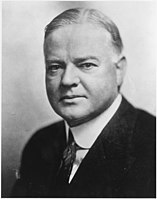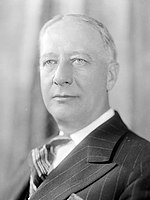| ||||||||||||||||||||||||||
| ||||||||||||||||||||||||||
 County Results
| ||||||||||||||||||||||||||
| ||||||||||||||||||||||||||
| Elections in North Carolina |
|---|
 |
The 1928 United States presidential election in North Carolina was held on November 6, 1928. North Carolina voters chose twelve electors to the Electoral College, who voted for president and vice president.
As a former Confederate state, North Carolina had a history of Jim Crow laws, disfranchisement of its African-American population and dominance of the Democratic Party in state politics. However, unlike the Deep South, the Republican Party had sufficient historic Unionist White support from the mountains and northwestern Piedmont to gain a stable one-third of the statewide vote total in most general elections,[1] where turnout was higher than elsewhere in the former Confederacy due substantially to the state’s early abolition of the poll tax in 1920.[2] A rapid move following disenfranchisement to a completely “lily-white” state GOP also helped maintain Republican support amongst the state’s voters.[3] Like Virginia, Tennessee and Oklahoma, the relative strength of Republican opposition meant that North Carolina did not have statewide White primaries, although certain counties did use the White primary.[4]
At the beginning of October, polls were suggesting that despite the divide in the state’s Democrats, Smith would carry the state, and he visited Raleigh in mid-October.[5] This prediction of a Smith victory despite Protestant opposition to his Catholicism and his anti-Prohibition views seemed confirmed in the days before the poll.[6] However, with late counting, it became apparent that Smith had lost the state alongside Virginia, Florida and Texas.[7]
Hoover’s victory was due to a combination of anti-Catholicism – at its strongest in the fishing communities of the Outer Banks, where he carried several counties that had gone to John W. Davis in 1924 by four- or five-to-one margins – with increasing middle-class Republican voting in such cities as Charlotte, Durham and Greensboro.[8] Although the state’s Black Belt remained extremely loyal to Smith,[9] this was not enough to come close to holding the state against traditional Appalachian Republicanism alongside urban and Outer Banks trends against him. Overall, Hoover won North Carolina by 9.88 percent, which made it his second-best state in the former Confederacy after Florida, and the only occasion between 1876 and 1964 in which North Carolina would vote Republican. The state would subsequently vote solidly Democratic until Richard Nixon won it in 1968.
As of the 2020 presidential election[update], this is the last election in which Orange County voted for a Republican presidential candidate.[10]
- ^ Phillips, Kevin P.; The Emerging Republican Majority, pp. 210, 242 ISBN 978-0-691-16324-6
- ^ Key, Valdimer Orlando; Southern Politics in State and Nation, p. 502, Alfred A. Knopf (1949)
- ^ Heersink, Boris; Jenkins, Jeffery A. (2020). Republican Party Politics and the American South, 1865–1968. Cambridge University Press. pp. 48–50, 239–243. ISBN 9781316663950.
- ^ Klarman, Michael J. (2001). "The White Primary Rulings: A Case Study in the Consequences of Supreme Court Decision-Making". Florida State University Law Review. 29: 55–107.
- ^ Merrill, Charles (October 11, 1928). "Raleigh Will Give Smith Warm Welcome Today: North Carolina Seems Safe For Governor Unless Simmons Comes Out For Hoover, Says Merrill". Daily Boston Globe. p. 16.
- ^ "State Forecasts Lean to Hoover: Reports From Close States Take View That He Is Stronger Than Smith". The New York Times. November 4, 1928. p. 33.
- ^ "Hoover's Plurality 5,000,000, Congress Safely Republican: Late Returns Add to Republican Nominee's Hold On 40 States and Electoral Vote of 444". Daily Boston Globe. November 8, 1928. p. 1.
- ^ Phillips; The Emerging Republican Majority, pp. 212-215
- ^ Phillips, The Emerging Republican Majority, p. 303
- ^ Sullivan, Robert David; ‘How the Red and Blue Map Evolved Over the Past Century’; America Magazine in The National Catholic Review; June 29, 2016

